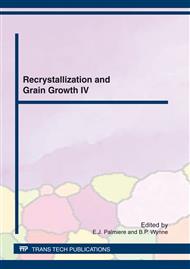p.924
p.930
p.936
p.940
p.946
p.952
p.953
p.959
p.965
Magnetically Affected Texture and Microstructure Evolution during Grain Growth in Zirconium
Abstract:
The effect of a magnetic field on texture and microstructure development in cold rolled (80%) commercially pure zirconium (Zr701) was investigated. X-ray diffraction and EBSD measurements were utilized for the texture and microstructure characterization. The results revealed that a magnetic field promotes grain growth in the investigated material. During annealings at 550°C this is particularly apparent from the faster development of specific (0/180, 35, 30) texture components and the bigger mean grain size after magnetic annealing. The magnetic annealing at 700°C resulted in an asymmetry of the two major texture components. This is due to a magnetic driving force for grain growth arising from the anisotropic magnetic susceptibility of zirconium. During annealing at 700°C the abnormal grain growth occurred. This behavior is attributed to the higher mobility of grain boundaries between grains misoriented by 30° around [000. The magnetic field essentially enhanced the observed abnormal grain growth.
Info:
Periodical:
Pages:
946-951
Citation:
Online since:
April 2012
Authors:
Keywords:
Price:
Сopyright:
© 2012 Trans Tech Publications Ltd. All Rights Reserved
Share:
Citation:


